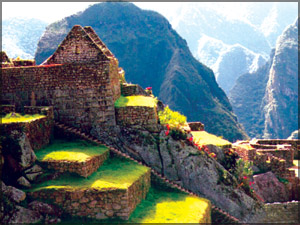Landmarks
Little Blue Birdie's Diary
Machu Picchu, Peru's sacred site
Dear Diary,
As we had promised the week before last, we are back in our journey
through the Modern World Wonders. This time we thought of visiting Machu
Picchu in Peru. In spite of its tongue-twisting name, this place is
almost a heaven on Earth.
Machu Picchu means 'Old Peak' in the Quechua language. Surrounded by
the high mountains which add to the scenic beauty of the area, Machu
Picchu has archaeological importance as well. It is popular as one of
the most beautiful archaeologically important places in the world. the scenic beauty of the area, Machu
Picchu has archaeological importance as well. It is popular as one of
the most beautiful archaeologically important places in the world.
The ruins of Machu Picchu were rediscovered in 1911 by Yale
archaeologist Hiram Bingham. While the Inca people certainly used the
Andean mountain top, which is situated 9,060 feet above sea level,
erecting many hundreds of stone structures from the early 1400s, legends
and myths indicate that Machu Picchu was worshipped as a sacred place
from a far earlier time. Whatever its origins, the Incas turned the site
into a small (five square miles), but extraordinary city.
This place is invisible from below and is completely independent. It
is also surrounded by agricultural fields, which are sufficient to feed
the population, and watered by natural springs. Machu Picchu seems to
have been used by the Incas as a secret ceremonial city.
Located two thousand feet above the Urubamba River, the ruins include
those of palaces, baths, temples, storage rooms and some 150 houses, all
in a remarkable state of preservation.
These structures, carved from the gray granite of the mountaintop,
are both architectural and aesthetic wonders. Many of the building
blocks weighing 50 tons or more are so precisely sculpted and fitted
together with such accuracy, that the joints will not permit the
insertion of even a thin knife blade.
Not many details have been found about the social or religious use of
the site during Inca times. The skeletal remains of ten females to one
male had led to the casual assumption that the site may have been a
sanctuary for the training of priestesses and/or brides of the Inca
people. remains of ten females to one
male had led to the casual assumption that the site may have been a
sanctuary for the training of priestesses and/or brides of the Inca
people.
One of Machu Picchu's primary functions was that of an astronomical
observatory. The Intihuatana stone, which means 'Hitching Post of the
Sun', has been shown to be a precise indicator of the date of the two
equinoxes and other significant celestial periods.
At midday on March 21 and September 21, the Sun stands almost
directly above this pillar, creating no shadow at all. At this precise
moment, the Sun "sits with all his might upon the pillar", and is for a
moment 'tied' to the rock.
At these periods, the Incas held ceremonies at the stone in which
they 'tied the sun' to halt its northward movement in the sky. There is
also an Intihuatana alignment with the December solstice, the summer
solstice of the southern hemisphere (Solstice is either of the times
when the Sun is farthest from the equator, on or about June 21 or
December 21.
The summer solstice falls in June in the northern hemisphere, but in
December in the southern hemisphere, and vice versa for the winter
solstice), when at sunset the sun sinks behind the Pumasillo (the Puma's
claw), the most sacred mountain of the western Vilcabamba range, but the
shrine itself is primarily equinoctial (to do with the equinox).
Shamanic legends, legends which are related to a range of traditional
beliefs and practices concerned with communication with the spirit
world, say that when a sensitive person touches his/her forehead to the
stone, the Intihuatana opens his/her vision to the spirit world. communication with the spirit
world, say that when a sensitive person touches his/her forehead to the
stone, the Intihuatana opens his/her vision to the spirit world.
Intihuatana stones were the supremely sacred objects of the Inca
people. The Incas believed that if the Intihuatana stone at an Inca
shrine was broken, the gods of the place would die or depart.
The mountaintop sanctuary was neglected and abandoned forty years
later, after the Spanish took Cuzco in 1533. The Spaniards never found
Machu Picchu, even though they suspected its existence, thus the
Intihuatana stone and its resident spirits 'remained in their original
position'. Supply lines linking the many Inca social centres were
disrupted and the great kingdom ended.
That is the story of Machu Picchu. I hope to fill in more pages of
this diary with details from more World Wonders. Till then, bye!
Comments: [email protected]
|
